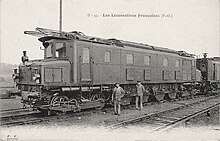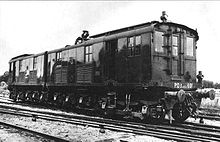PO E 501 and 502
| PO E 501 and 502 SNCF 2D2 5500 |
|
|---|---|
|
PO E 502 in 1926
|
|
| Numbering: | PO E 501 and 502 SNCF 2D2 5501 and 5502 |
| Number: | 2 |
| Manufacturer: | SLM , BBC |
| Year of construction (s): | 1925 |
| Retirement: | 1969 |
| Axis formula : | 2'Do2 ' |
| Gauge : | 1435 mm ( standard gauge ) |
| Length over buffers: | 17,780 mm |
| Service mass: | 125 t |
| Top speed: | 130 km / h |
| Hourly output : | 3052 kW (4150 hp) |
| Driving wheel diameter: | 1750 mm |
| Impeller diameter front: | 970 mm |
| Power system : | 1500 V DC |
| Power transmission: | Contact line , side busbar |
| Number of traction motors: | 4th |
| Drive: | Buchli drive on both sides |
The electric locomotives E 501 and E 502 of the Chemin de fer de Paris à Orléans (PO), later 2D2 5501 and 2D2 5502 of the SNCF , were two test locomotives for the express train service on the railway line Paris - Vierzon electrified with 1500 V direct current . The locomotives were groundbreaking for the construction of express train locomotives in France until the 1950s , which is why they were nicknamed Grand-mère "Grandmother".
history
Under the direction of chief engineer Hippolyte Parodi , the PO electrified its main line from Paris to Vierzon before the Second World War . In addition to 200 four-axle locomotives for use in front of freight and passenger trains, express locomotives were also required for train transportation. Because there was little experience with high-speed electric locomotives, five prototype locomotives from three different manufacturers were ordered in 1923.
The E 601 from America did not prove itself. The high unsprung mass of the axle motors did not allow the locomotive to go faster than 100 km / h without risking derailment. Likewise, the rod drive designed by Kandó for the E 401 and E 402 built in Hungary was unsuccessful. The bars were fragile and had to be readjusted frequently. Only the locomotives E 501 and E 502 from Switzerland were able to reliably run express trains at 120 km / h and thus replace steam operation in this area. The locomotives exceeded the PO's expectations. They were able to cover the Vierzon – Paris route in under two hours and maintained a speed of 125 km / h for a long time. During test drives, the E 502 reached a top speed of 150 km / h several times. The later series locomotives bore the numbers E503 – E537 and were later classified together with the prototypes and other replicas in the SNCF class 2D2 5500. The locomotives were assigned to the Paris Sud-Ouest depot for the entire period of operation.
Overview of the prototypes
| Numbers | Nickname | Manufacturer | Axis formula | drive | image | Discarded |
|---|---|---|---|---|---|---|
| E 401-402 |
Hongroise
"Hungarian" |
All | (2'B) (B2 ') | Rod drive |

|
1945 |
| E 501-502 |
Grand-mère
"Grandmother" |
SLM , BBC | 2'Do2 ' | Buchli drive |

|
1969 |
| E 601 |
Gearless
"Gearless" |
GE , Alco | 2'Co + Co2 ', later (2'Co) (Co2') |
Axis motors |

|
1938 |
technology

The locomotives were constructed similarly to the SBB Ae 3/6 I , but had four driving axles and a bogie at both ends . This was equipped with a laterally movable pivot that was centered with springs - a design that was later called the Winterthur type . For the test drives, the bogies were also equipped with a folding drawbar, which allowed the pivot point of the bogie to be positioned at three different locations in the longitudinal direction of the locomotive, with one position outside the bogie in the direction of the driving axles.
The six-pole drive motors of the type GLM85 / 6-43 were very powerful for the time and had an external ventilation system that was not yet common at the time, with each drive motor having its own fan. Each traction motor drove its assigned axle via two Buchli drives with a gear ratio of 56: 143 on both sides of the vehicle . The traction motors of the E 502 were also provided with compensation windings . The locomotives were also equipped with a recuperation brake, which was hardly of any use when used on the plain. In contrast to the series locomotives, the prototypes, in addition to the pantographs, were also provided with grinding shoes for the power supply through a laterally arranged conductor rail , which was arranged on the bogies.
Outwardly, the E 501 and E 502 differ from the series locomotives in that they have only six instead of eight windows in the side wall of the engine room. Furthermore, they were only equipped with four small sandboxes, which only sanded the first and third driving axles in the direction of travel - the series locomotives had sand pipes on all driving axles for both directions. The center distance of the prototypes between the second and third driving axles was slightly larger at 2050 mm than between the other driving axles, where it was 1850 mm. In the case of the series locomotives, all distances were 2020 mm.
Web links
Individual evidence
- ^ A b c Jean-François Picard: L'électrification du 'Paris-Orléans', le grand œuvre d'Hippolyte Parodi. In: archivchemindefer.free.fr. Retrieved May 2, 2016 .
- ↑ 2D2 5500. In: Engins Ferroviaires en France. Retrieved May 2, 2016 .
- ^ Announcement from the SLM: Innovations in the mechanical structure of electric express train locomotives . In: Schweizerische Bauzeitung . tape 89 , no. 13 , 1927, pp. 174-175 , doi : 10.5169 / seals-41673 .
- ↑ a b Les prototypes E 501 – E502 du PO. In: mapage.noos.fr. Retrieved May 2, 2016 .

